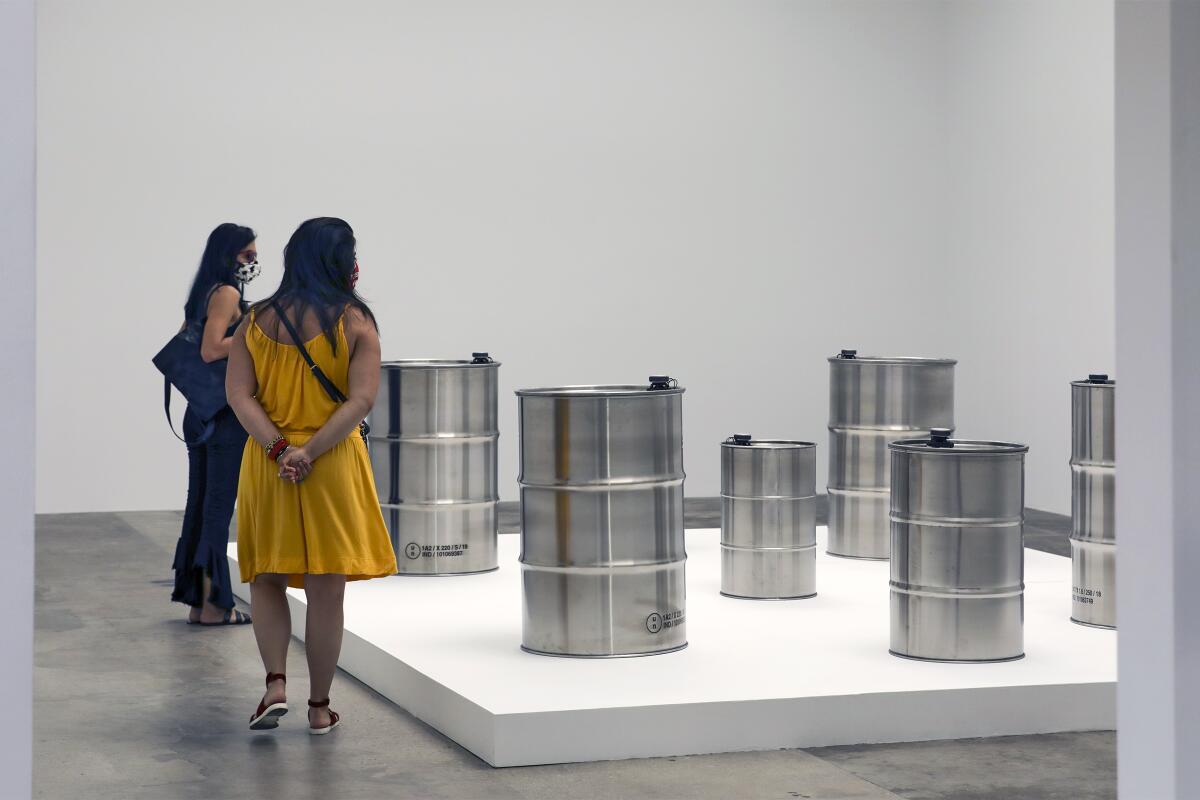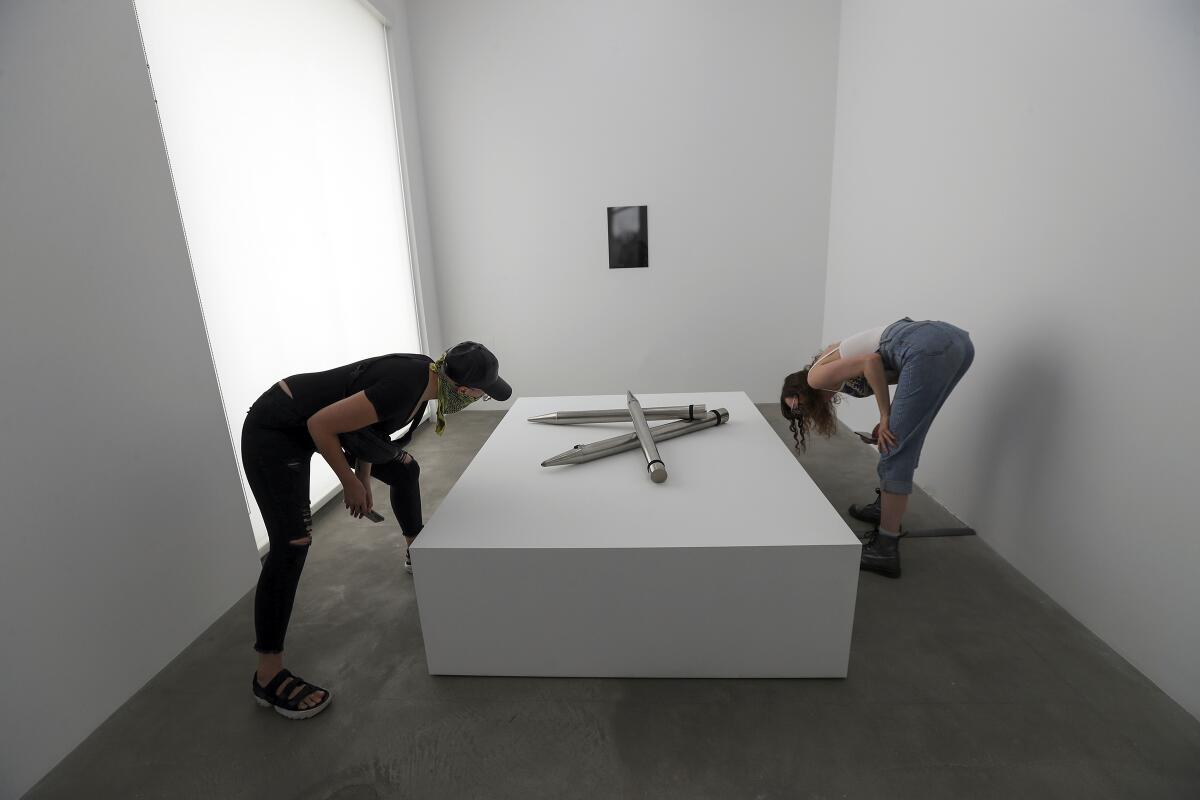I visited four reopened art galleries. The experience was not what I expected

- Share via
Confession No. 1: I wasn’t eager to get back into the galleries.
For months friends, fellow writers and artists have been audibly yearning to see art again, but I kept quiet. Looking at art, immersing myself in it and emerging from the deep soak to give shape to a response — this is primary nourishment for me, personally and professionally. Why would I be resistant to resuming my intake of oxygen?
I had an inkling but didn’t figure it out for sure until I finally did venture back recently: I had been afraid that going to galleries wouldn’t be like it used to be, that like so much else now, the experience would be rudely diminished, brutally compromised, akin to the stuttering Zoom call filling in for a tender embrace.
So when exhibition spaces did start opening up, I didn’t rush in. I held tight to memories of the familiar — and what was left of that?

Quite a bit, it turns out.
I visited four galleries, three by appointment and one as a drop-in. It wasn’t the old normal, of course, but neither was it the hassle nor the heartbreaker I dreaded. At the end of the day, I felt invigorated, quenched — and reassured.
Online reservations were a cinch. Each took just a few clicks. The hardest part is setting a schedule when it’s impossible to know how long you’ll want to stay at each stop. Galleries are typically allotting 30 minutes per visit, but when I did overstay, I was not shooed out the door.
I saw much less in a day than I ordinarily would, because I couldn’t pass in and out of adjacent galleries with the usual opportunistic ease. Some venues, though, are keeping their doors open to spontaneous wanderers and limiting traffic flow as needed. Checking gallery websites before visiting is a necessity. Calling is helpful too, although one gallery I tried to contact by phone to set an appointment didn’t answer.
The mood, in every place I did visit, was one of careful exuberance and genuine welcome. Mask use was universal, but within my small sampling there was a range of pandemic strategies and degrees of formality. Plexiglass barriers galore were installed in some places but none in others. Some galleries still offered paper handouts (press releases, title sheets) and even a carry-around plastic binder of information, but others made that material accessible only by QR code.
Did the outing feel risky? Not to me. The only risk I registered was exactly where it belonged: as a generative force in the art itself.
Paired shows at David Kordansky Gallery abounded in material ingenuity and experimentation. Ricky Swallow’s sculptures were taut tussles with art history, illusion, wit and metaphor. Swallow remakes the readymade, casting in bronze stagey combinations of familiar objects from home and studio (stepladder, rope, teacup, twine) as self-reflexive musings on making itself. “Step Ladder With Cane (cursive)” mused on motion and fixity, reading as a humble, elegant riposte to Duchamp’s “Nude Descending a Staircase.”
Swallow, based in L.A., curated the other show at Kordansky, a stirring installation of “Weed Pots” made between the ’50s and ’70s by the late, under-heralded Southern California ceramic sculptor Doyle Lane (both shows have since closed). The small vessels, each intended to hold a single sprig, bear pocked, matte, metallic, veined and glossy skins, in hues earthen, mineral and fiery. Looking from one of these objects of distilled grace and restless exploration to the next felt like glancing through the pages of the artist’s sketchbook.
An L.A. Times survey of Los Angeles art galleries on a slimmed-down post-pandemic future. Some are banding together to weather the storm.
During this long stretch when galleries were shuttered, I have — confession No. 2 — barely stepped foot, so to speak, in the online viewing rooms that have proliferated. OVRs are immensely useful in providing access to a cosmic encyclopedia of possibility, but each entry is just that, an abbreviated reference, too often taken as a sufficient substitute for the thing itself.
The instant consumability of those digital images is what disturbs me most. Spending time moving through and around the work by Swallow and Doyle made me feel the chasm between OVR and IRL experiences even more palpably.
What can happen in the patient, physical encounter with art can only be hinted at in the digital domain. The intimacy of Doyle’s pots, the slow-reveal magic of Swallow’s quasi-assemblages, the particularities of texture and the bodily resonance of scale — none of this can be adequately conveyed onscreen. Our screens serve as windows but also as barriers and dividers. We do indeed see more, but we perceive less.
As part of an alarming trend, a museum is selling a 1946 Jackson Pollock drip painting to raise money to diversify its collection. Good intention, bad plan.
Exhibition installation matters too, and the sometimes overt, sometimes subtle relationships between works on view are best sensed in the moment, through the flesh. At the L.A. gallery Nonaka-Hill, works by Kaz Oshiro spanning 17 years were assembled with deliberate casualness, in a space that looked either not quite ready to greet visitors or as if the show were already over. (Oshiro’s exhibition did indeed close over the weekend.) There was cardboard on the floor, and the walls were incompletely painted. A dumpster was parked in the middle of one room. A detached truck tailgate leaned against the wall, near I-beams that criss-crossed on the floor like so many pick-up sticks.
It was all an exquisitely orchestrated still-life tableau, dense with cultural critique. Most of the objects were paintings on canvas, meticulous fabrications slumming as random debris. In this rich twist on notions of value, the Japanese-born, L.A.-based Oshiro engages realism and artifice to the same end. Disillusion fuels his illusions.
Such robust, tightly conceived shows can feel like a generous gift to screen-sapped eyes, distracted minds and defeated spirits. Steve Turner Gallery was featuring a hearty trio of solo presentations: stylized portraits by Paris-based Rebecca Brodskis, assemblage portraits by New York-based David Shrobe and, most engrossing to me, “ceramic paintings” by Iowa City-based Kevin McNamee-Tweed.
McNamee-Tweed’s modestly sized, irregularly shaped panels are glazed, embossed and incised with images and words excavated from the artist’s mental attic — art prints, commercial signage, notes to self, calendar pages, flowers, smoking pipes. The neatened jumbles brought to mind Manny Farber’s domestic still-life self-portraits, themselves descended from centuries-old paintings by artists who used wall and tabletop as organizing surfaces of the memory and psyche, as well as storyboards of cultural history.
My final stop of the day, Tanya Bonakdar Gallery, brought me full circle with its inadvertently timely, potent meditation on breath. Breath is both carrier of sound and conduit of life. Only now is it regarded first of all as dangerous, the primary vehicle of viral transmission. In the emotionally insinuating work of Scottish-born, Berlin-based Susan Philipsz (on view through Saturday), the artist’s own breath is broadcast from inside organ pipes and photographed as condensation on panes of glass.

Presence as breath, breath as fleeting. In the form of Philipsz’s work, this essential principle becomes more charged than ever. Experiencing this show in person reminded me that we carry our entire world into every gallery we enter. When ensnared by what we find there, we carry that art right back out with us, where it can continue its necessary, vitalizing work.
More to Read
The biggest entertainment stories
Get our big stories about Hollywood, film, television, music, arts, culture and more right in your inbox as soon as they publish.
You may occasionally receive promotional content from the Los Angeles Times.










